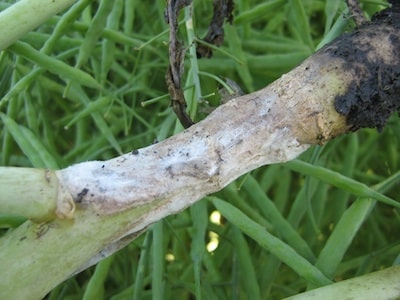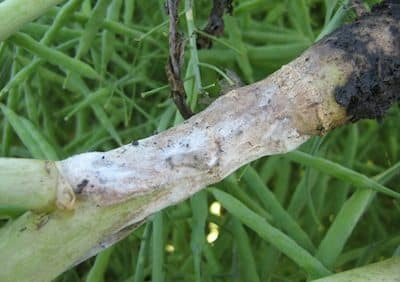
Sclerotinia stem rot infection is being found lower down the plant in many fields this year. Some fields are lodging because of sclerotinia infection. In some cases, sclerotinia infection is right near ground level, which is where blackleg is also found.
Typical symptoms of sclerotinia stem rot should be the same, even if damage is lower down the plant than expected.
—Stems infected with sclerotinia stem rot will be bleached or brown (like a bone) and may start to crack open or shred.
—Hard, black sclerotia bodies — similar in appearance of mouse droppings — found inside these bleached stems are a sure sign of sclerotinia stem rot. Not all sclerotinia-infected stems will have these. Or, in extreme cases, they may grow outside the stem.
—White, downy growth can be found on the outside of stems, although that has likely dried up by now.
Blackleg stems will be hard and gnarly at the base, and if you cut them open the tissue inside will be blackened. Click here for more tips on how to tell the diseases apart.
Sclerotinia stem rot infection that occurs lower on the plant is likely the result of very early infection, or fungus infecting the plant from infected leaves that had dropped to the ground.
Sclerotinia stem rot infection levels reduced. Official surveys have not been reported, but it seems that sclerotinia stem rot levels are lower this year than last year, in general. This is quite likely due to the dry turn during flowering. While wet conditions may have promoted large levels of spore dispersal leading up to flowering, dry conditions during and after flowering would have limited infection rates and severity. However, another factor is the benefit of fungicide. Many growers opted to spray this year. A CCC agronomy specialist surveyed a field where the grower left a check strip. Sclerotinia was on 15% of plants in the untreated area and on less than 1% in the treated area. We’d like reports from other check strips. If you left check strips in fungicide-treated canola, would you mind sharing your results with us? Contact us.
